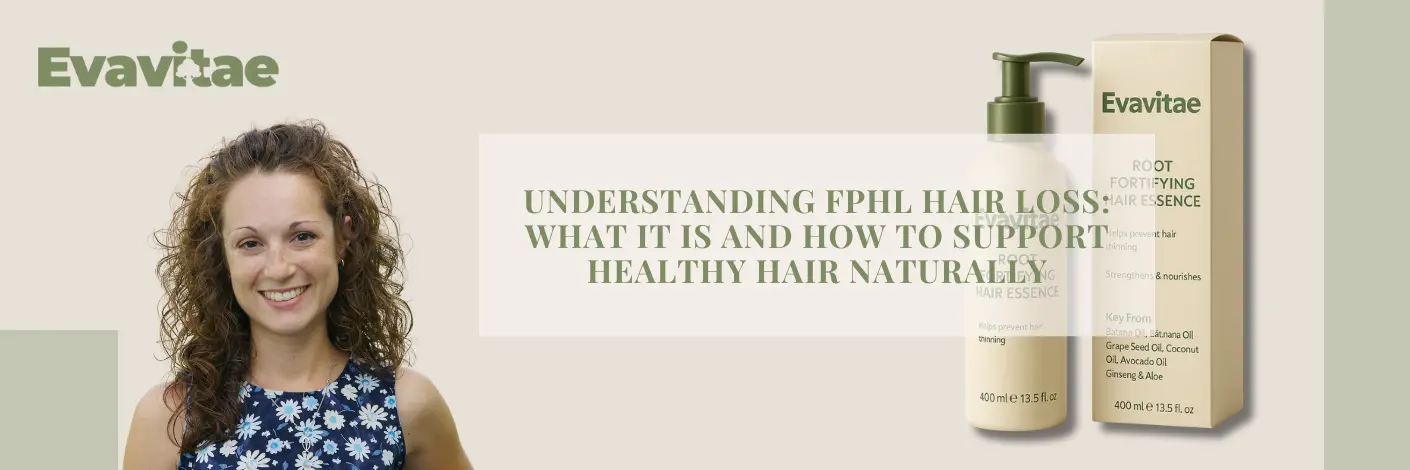
Female pattern hair loss (FPHL hair loss) is a common and often emotionally challenging condition many women face. At Evavitae, our mission is to gently support every woman’s journey toward healthier hair. Here’s a kind, knowledge-based guide to help you understand FPHL—rooted in science, full of empathy, and free from hard-sell language.
What Is FPHL Hair Loss?
FPHL, or female pattern hair loss, is the most prevalent form of non-scarring alopecia in women. It’s characterized by gradual thinning across the scalp, especially in the central and frontal areas, while the hairline typically remains intact (American Academy of Dermatology, PMC). Unlike male-pattern baldness, FPHL usually doesn’t lead to full baldness, but can significantly affect hair volume and confidence(PMC+1).
By age 50, an estimated 40% of women show signs of FPHL, making it a widespread yet underdiscussed concern. At Evavitae, we believe addressing the topic with compassion encourages early recognition and thoughtful care.
What Causes FPHL Hair Loss?
1. Genetics and Hormonal Influence
FPHL has a clear genetic component—multiple genes contribute to predisposition, and inheritance can come from either parent via polygenic patterns. Hormonal factors, particularly androgens like DHT, are believed to influence follicle miniaturization, though the exact hormonal pathways in women remain complex.
If your recent shedding followed pregnancy, you may also appreciate this practical guide to natural, confidence-building care after postpartum hair loss—with tips for choosing a kinder shampoo routine.
2. Follicular Miniaturization
The key hallmark of FPHL is the progressive transformation of robust, thick (terminal) hair into fine, short (vellus-like) hair—referred to as “follicular miniaturization”. This process often shortens the hair’s growth phase (anagen) while increasing the resting phase (telogen), resulting in overall thinning.
3. Age and Lifestyle Factors
The likelihood and visibility of FPHL increase with age, especially during and after menopause, when hormonal shifts may accelerate follicle sensitivity(Cleveland Clinic). Additionally, oxidative stress, scalp health, and metabolic factors may influence progression.
Why Gentle Care Matters (From Evavitae’s Heart)
FPHL can take a toll not just on hair, but on emotional well-being. Women with FPHL often report feelings of insecurity, anxiety, and social strain (DermNet). That’s why Evavitae focuses on gentle, nourishing care—supporting hair from the outside while promoting confidence from the inside.
Evidence-Based Treatments for FPHL
Although there’s no instant cure, several approaches are well-supported:
Topical Minoxidil
Minoxidil is the only FDA-approved treatment for FPHL. Available in 2% and 5% formulations, studies show twice-daily 2% use or once-daily 5% use can significantly increase non-vellus (thicker) hairs over 48 weeks, helping stabilize hair loss.
Anti-androgen Therapies
In cases linked to hormone imbalances or hyperandrogenism (like PCOS), treatments with spironolactone or cyproterone acetate—often combined with minoxidil—can yield improvement in many women. These therapies are typically prescribed under medical supervision.
Combination and Adjunctive Treatments
Combining minoxidil with other modalities—like low-level laser therapy (LLLT), microneedling, or platelet-rich plasma (PRP)—may enhance results, though evidence varies (Wikipedia).
Professional Evaluation
Consulting a dermatologist helps differentiate FPHL from other conditions like telogen effluvium or alopecia areata. Early diagnosis increases the likelihood of treatment success and avoids missteps.
Integrating Gentle Care into Daily Life
While treatments work on a biological level, lifestyle habits nurture—and protect—the hair you have:
- Daily scalp-friendly routines: Use mild, supportive products that minimize irritation while hydrating follicles—like those Evavitae crafts with clean botanical and peptide blends.
- Balanced diet: Ensure adequate protein, iron, vitamins (D, B-complex), and healthy fats.
- Stress modulation: Emotional load and excess cortisol can aggravate FPHL, so stress relief matters.
- Protective styling: Avoid tight hairstyles or harsh chemicals that can compound shedding or damage.
Empowering You with Knowledge and Support
FPHL hair loss is real, common, and deeply personal. But you’re not alone. Educating yourself is the first act of self-compassion. Paired with medical guidance and gentle, consistent care, many women experience stabilization—and even regain density.
At Evavitae, we design with sensitivity in mind, offering formulas that complement proactive treatments—not replace them. Think of Evavitae as part of your supportive care team: calm, kind, and scientifically aware.
💡 Curious about causes and recovery paths for hair loss? Read more in our Hair Loss 101 Hub.
Discover what really helps after childbirth in our Postpartum Hair Recovery Guide.
Evavitae products are now available exclusively at www.evavitae.com.




Add comment
You must be logged in to post a comment.